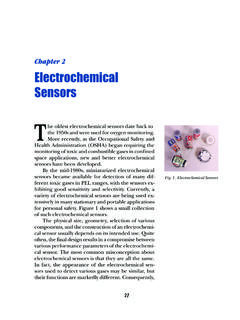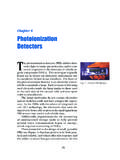Transcription of Chapter 3 Catalytic Combustible Gas Sensors
1 37 Chapter 3 Catalytic Combustible Gas SensorsChapter 3 Catalytic CombustibleGas SensorsCatalytic bead Sensors are used primarily to de-tect Combustible gases. They have been in usefor more than 50 years. Initially, these sensorswere used for monitoring gas in coal mines, wherethey replaced canaries that had been used for a longperiod of sensor itself is quite simple in design and iseasy to manufacture. In its simplest form, as used inthe original design, it was comprised of a single plati-num wire. Catalytic bead Sensors were produced allover the world by a large number of different manu-facturers, but the performance and reliability of thesesensors varied widely among these various manufac-turers.
2 A Catalytic bead sensor is shown in Figure of OperationCombustible gas mixtures will not burn until theyreach an ignition temperature. However, in the pres-ence of certain chemical media, the gas will start toburn or ignite at lower temperatures. This phenom-enon is known as a Catalytic combustion. Most metaloxides and their compounds have these Catalytic prop-erties. For instance, volcanic rock, which is comprisedof various metal oxides, is often placed in gas burningfireplaces. This is not only decorative, but it also helpsFig. 1 A Catalytic Bead Sensor38 Hazardous Gas Monitorsthe combustion process and results in cleaner andmore efficient burning in the fireplace.
3 Platinum,palladium, and thoria compounds are also excellentcatalysts for combustion. This explains why the auto-mobile exhaust system is treated with platinum com-pounds and is called a Catalytic converter. This kindof gas sensor is made on the basis of the Catalytic prin-ciple, and therefore is called the Catalytic gas gas molecule oxidizes on the catalyzed surfaceof the sensor at a much lower temperature than itsnormal ignition temperature. All electrically conduc-tive materials change their conductivity as tempera-ture changes. This is called the coefficient of temperatureresistance (Ct). It is expressed as the percentage ofchange per degree change in has a large Ct in comparison to othermetals.
4 In addition, its Ct is linear between 500 C to1000 C, which is the temperature range at which thesensor needs to operate. Because the signal from thesensor is linear, this means that the concentration ofgas readings are in direct proportion to the electricalsignal. This improves the accuracy and simplifies theelectronic circuitry. Also, platinum possesses excel-lent mechanical properties. It is physically strong andcan be transformed into a fine wire which can be pro-cessed into small sensor , platinum has excellent chemicalproperties. It is corrosion resistant and can be oper-ated at elevated temperatures for a long period of timewithout changing its physical properties.
5 It is capableof producing a constant reliable signal over an ex-tended period of electrical circuit used to measure the outputof Catalytic Sensors is called a Wheatstone bridge, in honorof English physicist and inventor Sir Charles Wheat-stone (1802-75). Wheatstone bridges are commonlyused in many electrical measurement circuits. Asshown in Figure 2, four circuit branches are arrangedOUTPUTRBR1 Active BeadReference POWERRBFig. 2 A Catalytic bead sensorWheatstone bridge a circuit formeasuring an unknown resist-ance by comparing it with 3 Catalytic Combustible Gas Sensorsin a square. The source of the electrical current is con-nected, and between the other pair of opposite cor-ners, the output measurement circuit is operation, R1 is the trim resistor that keeps thebridge balanced.
6 A balanced bridge has no output sig-nal. Resistor value RB and trim pot R1 are selected withrelatively large resistance values to ensure proper func-tion of the circuit. When the gas burns on the activesensor surface, the heat of combustion causes the tem-perature to rise, which in turn changes the resistanceof the sensor. As the bridge is unbalanced, the offsetvoltage is measured as the signal. It is important thatthe reference sensor or bead maintains a constant re-sistance during the exposure to the Combustible gas;otherwise, the measured signal will be of the sensor. The original Catalytic sen-sor was a coil-shaped platinum wire. The coiled shape,illustrated in Figure 3, was used to obtain a compactgeometry for efficient heating and to produce a strongenough signal to function as a gas sensor.
7 Unfortu-nately, despite the excellent physical and chemicalproperties of platinum, it is a poor catalyst for com-bustion of hydrocarbon the proper detection of hydrocarbon gases,the sensor requires a heated surface temperature be-tween 900 C and 1000 C so that the sensor can prop-erly react with gases at a sufficiently high and stablerate. At this temperature, however, the platinum startsto evaporate. The evaporation rate increases as thegas molecules start to react with the sensor and as thesensor temperature increases. This causes a reduc-tion in the cross-section of the platinum wire, and, asa result, the resistance increases. This affects thesensor s operating temperature, which shows up as zeroand span reference wire ideally should be the same asthe active wire, with the same geometry and operat-ing temperature, but should be nonreactive with theFig.
8 3 Hot Wire Sensor40 Hazardous Gas Monitorsgas. This is not practically possible, however. A com-promise is made by operating the reference wire at atemperature that is substantially lower so that no oxi-dation takes place in the presence of addition, the reference wire is chemically treatedto reduce the Catalytic property of the platinum. Thismay also be achieved by coating platinum wire with anon- Catalytic metal, such as problem with hot platinum wire is that itbecomes very soft at a temperature of 1000 C. There-fore, it is difficult to maintain its coil shape. Also, thecoefficient of thermal resistance becomes less linearas the temperature increases. This situation also re-sults in poor zero and span quality of the sensor, aswell as a relatively short operating way to improve stability of the sensor is tocoat the platinum wire with suitable metal , the final step is to treat the finished sensor orbead with a catalyst, such as platinum, palladium orthoria compounds.
9 Figure 4, shows the sensor bead. PLATINUM WIRECATALYTICALLY-TREATEDMETAL OXIDEFig. 4 A Catalytic Bead SensorThe construction of the Catalytic sensor bead isanalogous to constructing a building by using rein-forced concrete. The coating makes the sensor physi-cally very rugged. The sensor becomes a very small41 Chapter 3 Catalytic Combustible Gas Sensorsmass which helps make it resistant to shock and vibra-tions. Most importantly, the catalyst coating reducesthe temperature needed to achieve a stable signal forhydrocarbons between 400 C and use of fine diameter wire not only reducesthe size of the sensor, but it also increases the signal,because finer wire has a higher magnitude of resistivevalue and the signal output is the percentage changeof total wire resistance.
10 This also reduces power reference sensor can be constructed in thesame way as the active sensor, with the exception thatthe catalyst chemical is eliminated. The bead can befurther treated with chemicals, such as potassium, toprevent the reference bead from reacting with the near perfectly compensated pair of Sensors is nowpossible. The sensor is called a Catalytic sensor be-cause the use of the catalyst is the main ingredientinvolved in the proper functioning of the sensor. Thecatalytic sensor is stable, reliable, accurate, and rug-ged, and has a long operating life. The output is lin-ear because the platinum wire has a good linear coef-ficient of thermal sensor s output is directly in proportion tothe rate of oxidation.
















